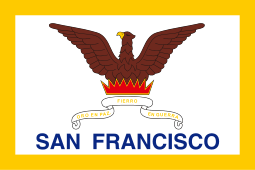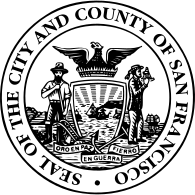Flag of San Francisco
The flag of the City and County of San Francisco, which depicts a rising phoenix, is often assumed to be symbol of the city's recovery from the 1906 earthquake and subsequent fires. However, the flag traces its origins to 1900. The Board of Supervisors of the City and County of San Francisco codified the design of the current flag on December 16, 1940.
 | |
| Use | Civil flag |
|---|---|
| Adopted | December 16, 1940. This version is c.2010. |
| Design | A white field with a yellow border, with a phoenix rising from flames. On a ribbon below, "Oro en paz. Fierro en guerra." with "SAN FRANCISCO" in blue at the bottom. |
History

.svg.png)

In 1900, banker and art patron Mayor James Duval Phelan, mayor from 1897 to 1902, recommended to the Board of Supervisors of the City and County of San Francisco that San Francisco adopt a flag and motto. A contest was held, and more than one hundred proposals were submitted. Policeman John M. Gamble's proposal was selected.
Gamble's concept depicted a black phoenix rising from gold flames on a white field. The mythological phoenix appears in many ancient cultures and is a symbol of immortality. When the long-lived phoenix feels death is near, it builds a nest of aromatic wood and sets it afire. A new phoenix then arises from the ashes, just as San Francisco arose from the great fires of the 1850s.
Below the phoenix and flames, the Spanish motto "Oro en paz y fierro en guerra" ("Gold in Peace and Iron in War") was on a black ribbon. The motto refers to the city's then-recent experience during the Spanish–American War as the embarkation point for troops to the Philippines in 1898.[1]
Based on the motto, San Francisco's official city colors now are gold and black; these two colors decorate the dome of San Francisco City Hall.
Design
The original design of the San Francisco flag was executed in 1900 by Robert Ingersoll Aitken.[2] Now best known as a sculptor, Aitken would go on to create both the Victory figure atop the Dewey Monument, in San Francisco's Union Square, and the figures, above the inscription "Equal Justice Under Law," that preside over the famous entrance to the U.S. Supreme Court Building.
Aitken's design was in use from 1900 until sometime in the early to mid 1930s.
Sometime in the 1930s, the Aitken design was replaced with a design the featured different artwork and introduced several more colors.
In December 1940, the Board of Supervisors added to the "new" flag the name "San Francisco" in bold, blue letters and codified all of these elements as the official San Francisco flag.
The yellow border, now reproduced as a part of the flag, was originally intended to be a gold fringe, but mistakenly became incorporated into the design. When used indoors, as is the custom, a gold fringe is added to what was originally intended to be the fringe.
See also
References
- Caption from the "War & Dissent: The U.S. in the Philippines, 1898-1902" exhibit. Curated by Randolph Delehanty, Ph.D. of the Presidio Trust.
- John Lumea, "The Original San Francisco Flag Was Better and Cooler. Let's Bring It Back!" 12 September 2018.
External links
- Flag of San Francisco at Flags of the World
- Roman Mars: Why city flags may be the worst-designed thing you've never noticed
